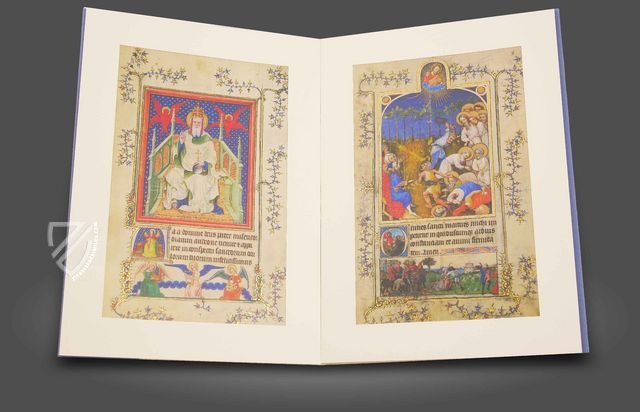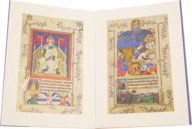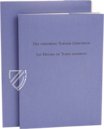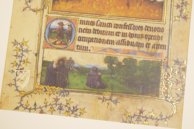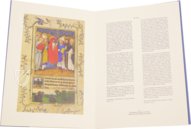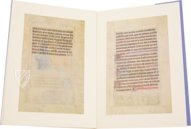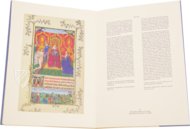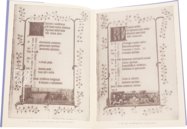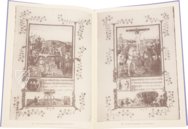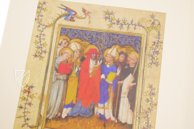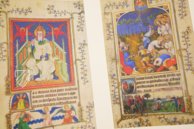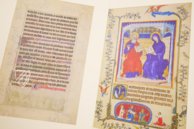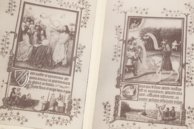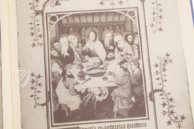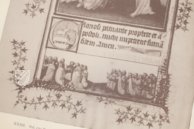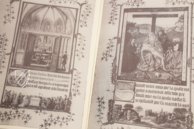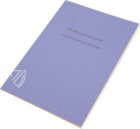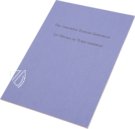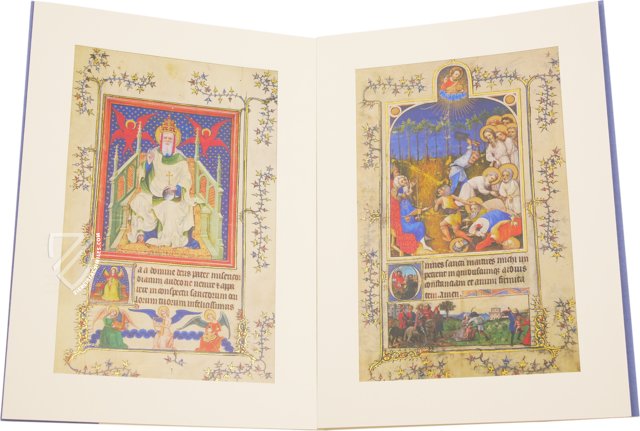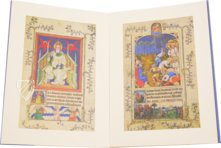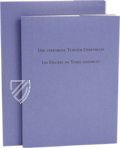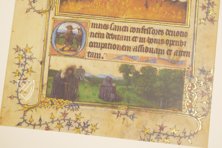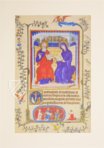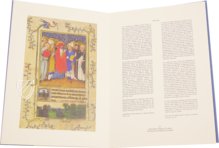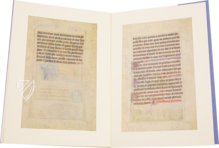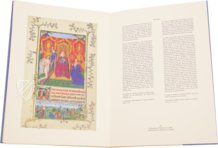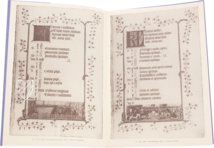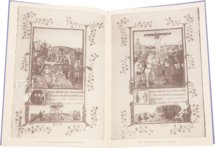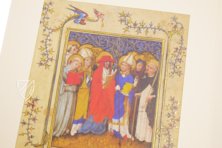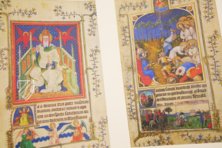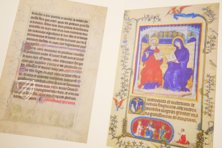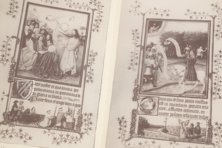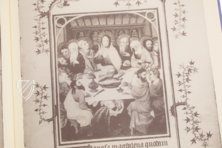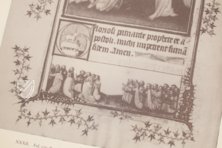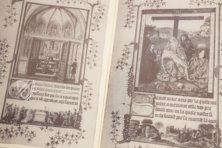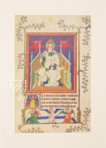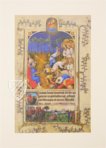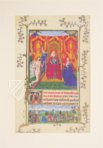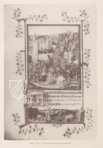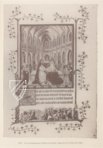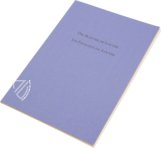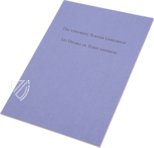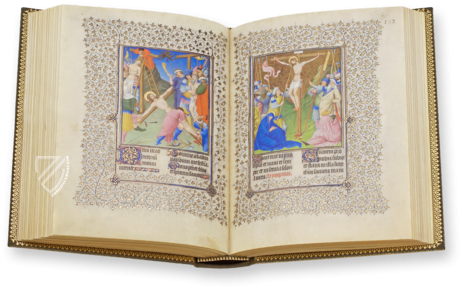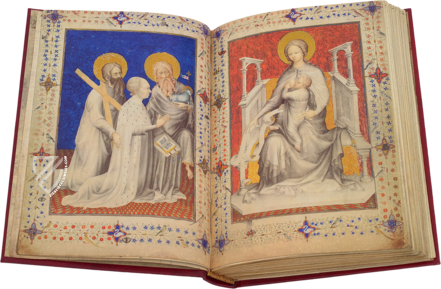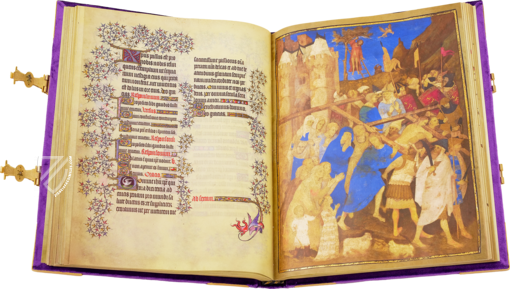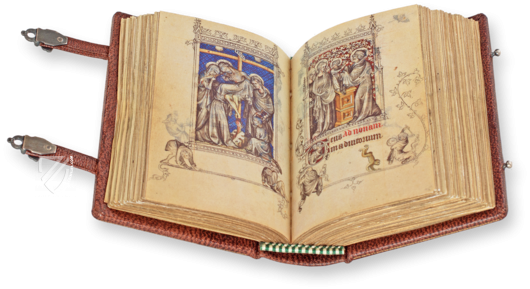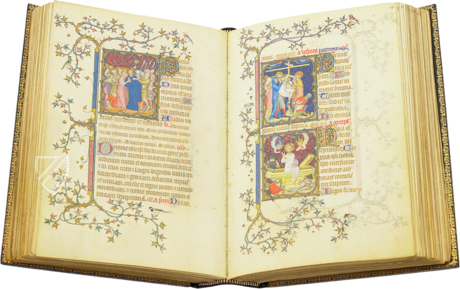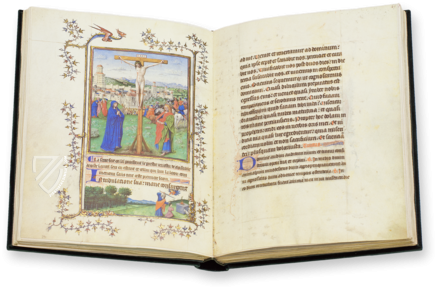Leaves of the Louvre and the Lost Turin Hours
(under 1,000€)
As the only remaining pages from the burnt Turin prayer book, these four sheets provide a wondrous glimpse into the grandeur and high quality of the original artistic arrangement of the manuscript. The master of Parament of Narbonne, Jan van Eyck, and his artistic circle of colleagues were the artists of the picture pages. The fateful story of the prayer book only serves to stress the importance of the four remaining pages of in the Louvre.
Leaves of the Louvre and the Lost Turin Hours
Standing before you are the only remaining four pages of the great manuscript treasure of the 15th Century; the pieces of the Très Belles Heures (Turin Hours) of the Duke of Berry. The prayer book was retained in Turin, but fell victim to a 1904 fire. Only the four sheets remain today, but nonetheless testify to the splendor and artistry of the origin, important prayer book.
A Great Master at Work
The five miniatures on the four pages of the “Leaves of the Louvre” derive from the hands of the great artists of its time. The master of Parament of Narbonne was responsible for the original design. Jan van Eyck and his colleagues partly filled out and completed all of the missing sections of the miniature pages. The precious miniatures pages inspire with artfully draped foliage, grandiose initials, playful bas-de-page-miniatures and especially the main scenes in bright colors and well thought-out composition. The latter part appears in its detailed execution almost as its own panel painting. The fact that this work of art is still available to seen to this day is truly a fortunate circumstance to be grateful for.
A Disastrous History
Duke Jean of Berry was the patron of the Très Belles Heures. For reasons unknown, he gave the manuscript to his treasurer Robinet d’Estampes in 1412, who opted to divide the book into three parts, later deciding to sell two of them to the House of Bavaria-Holland. The portion he maintained is well-known today as the Très Belles Heures de Notre Dame. The prayer book, which came together with the so-called Turin-Milan Book of Hours, ended up in the House of Bavaria-Holland, which commissioned in 1424 the young Jan van Eyck to finish it. After several other stations, the book ended up in 1720 with the House of Savoyard in Turin, where it was retained in the National Library. By this time, historians believe the four pages, now called the “Leaves of the Louvre”, were already stolen from the book – perhaps due to for their special splendor? That unfortunate act would ironically be for the better, because the remainder of the Turin Prayerbook burned in 1904 during a fire in the Turin Library.
The Lucky Destiny
The four pages have called the Louvre home since the 19th Century. Originally the prayer book comprised of 93 pages with 40 of whom being whole-page paintings. The special feature of the Prayerbook are the unordinary, essentially one-of-a-kind prayers for Saints who incidentally are not found in the current Compendia. The illustrated miniatures testify to the artistry and mastery of the prayer book, which also is of an impressively high value from the perspective of Art History as well. The art historian Paul Durrieu arranged two years before the fire to have the picture pages of the Turin Prayerbook printed in black and white. Thus a shred of the grandeur and beauty of this late middle-aged manuscript is still somewhat about to be seen.
Codicology
- Alternative Titles
- Blätter im Louvre und das verlorene Turiner Gebetbuch
Turin-Mailänder Stundenbuch
Libro d'ore di Torino-Milano - Size / Format
- 4 leaves / 26.8 × 17.3 cm
- Origin
- France
- Date
- 1380–1420
- Epochs
- Style
- Language
- Script
- Gothic Textura Quadrata
- Illustrations
- 5 miniatures on 4 leaves. The brochure on the lost illustrations includes 40 additional black and white miniatures of the lost Turin Hours.
- Patron
- Jean, Duke of Berry (1340–1416)
- Artist / School
- Master of the Parement de Narbonne (fl. 1356–1408)
Master of the Llangattock Hours (fl. 1445–60)
Master of John the Baptist
School of Jan van Eyck - Previous Owners
- Jean, Duke of Berry (1340–1416)
House of Savoy
Leaves of the Louvre and the Lost Turin Hours
Maiestas Domini with the Christ of Sorrows and the Virgin Advocate
This splendid miniature by the Master of the Llangattock Hours depicts God the Father as a medieval king with scepter and globus cruciger enthroned before a splendid tapestry upheld by two angels. Exhibiting the bleeding wounds of the Passion and flanked by two more angels holding his bloody funerary shroud, Jesus kneels on the column that he was tied to during his flagellation on the left as the Virgin Mary kneels and presents the breast with which she nourished the Son of God on the right.
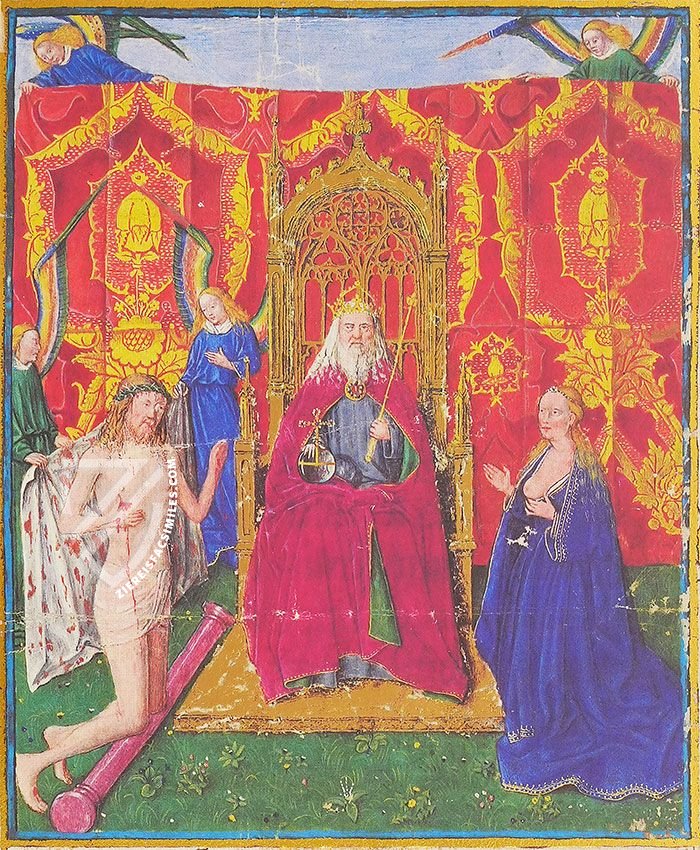
Leaves of the Louvre and the Lost Turin Hours
Scenes of Martyrdom
The Master of St. John the Baptist explores the theme of martyrdom on this splendid page through three images framed by artful red-blue-gold tendrils. He begins with the first Christian martyrs: the Massacre of the Innocents in the bas-de-page and St. Stephen kneeling in prayer as he is stoned to death in the historiated “O” initial above.
In the primary miniature, Christ blesses a group of martyrs as they are beheaded, two of whom lie on the ground next to their severed heads. Their pious facial expressions contrast the ugly grimaces of their executioners. One dressed in blue is about to strike a blow while the other, dressed in yellow, drags one of the victims by his hair in front of the seated figures, probably Roman officials.
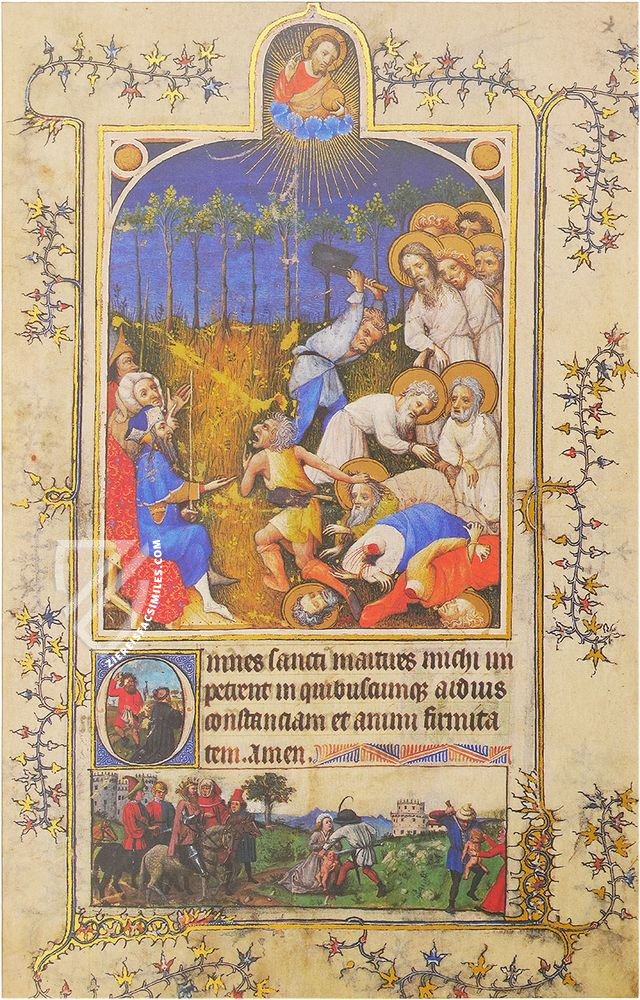
#1 Blätter im Louvre und das verlorene Turiner Gebetbuch
Languages: French, German
(under 1,000€)
- Treatises / Secular Books
- Apocalypses / Beatus
- Astronomy / Astrology
- Bestiaries
- Bibles / Gospels
- Chronicles / History / Law
- Geography / Maps
- Saints' Lives
- Islam / Oriental
- Judaism / Hebrew
- Single Leaf Collections
- Leonardo da Vinci
- Literature / Poetry
- Liturgical Manuscripts
- Medicine / Botany / Alchemy
- Music
- Mythology / Prophecies
- Psalters
- Other Religious Books
- Games / Hunting
- Private Devotion Books
- Other Genres
- Afghanistan
- Armenia
- Austria
- Belgium
- Belize
- Bosnia and Herzegovina
- China
- Colombia
- Costa Rica
- Croatia
- Cyprus
- Czech Republic
- Denmark
- Egypt
- El Salvador
- Ethiopia
- France
- Germany
- Greece
- Guatemala
- Honduras
- Hungary
- India
- Iran
- Iraq
- Israel
- Italy
- Japan
- Jordan
- Kazakhstan
- Kyrgyzstan
- Lebanon
- Liechtenstein
- Luxembourg
- Mexico
- Morocco
- Netherlands
- Palestine
- Panama
- Peru
- Poland
- Portugal
- Romania
- Russia
- Serbia
- Spain
- Sri Lanka
- Sweden
- Switzerland
- Syria
- Tajikistan
- Turkey
- Turkmenistan
- Ukraine
- United Kingdom
- United States
- Uzbekistan
- Vatican City
- A. Oosthoek, van Holkema & Warendorf
- Aboca Museum
- Ajuntament de Valencia
- Akademie Verlag
- Akademische Druck- u. Verlagsanstalt (ADEVA)
- Aldo Ausilio Editore - Bottega d’Erasmo
- Alecto Historical Editions
- Alkuin Verlag
- Almqvist & Wiksell
- Amilcare Pizzi
- Andreas & Andreas Verlagsbuchhandlung
- Archa 90
- Archiv Verlag
- Archivi Edizioni
- Arnold Verlag
- ARS
- Ars Magna
- ArtCodex
- AyN Ediciones
- Azimuth Editions
- Badenia Verlag
- Bärenreiter-Verlag
- Belser Verlag
- Belser Verlag / WK Wertkontor
- Benziger Verlag
- Bernardinum Wydawnictwo
- BiblioGemma
- Biblioteca Apostolica Vaticana (Vaticanstadt, Vaticanstadt)
- Bibliotheca Palatina Faksimile Verlag
- Bibliotheca Rara
- Boydell & Brewer
- Bramante Edizioni
- Bredius Genootschap
- Brepols Publishers
- British Library
- C. Weckesser
- Caixa Catalunya
- Canesi
- CAPSA, Ars Scriptoria
- Caratzas Brothers, Publishers
- Carus Verlag
- Casamassima Libri
- Centrum Cartographie Verlag GmbH
- Chavane Verlag
- Christian Brandstätter Verlag
- Circulo Cientifico
- Club Bibliófilo Versol
- Club du Livre
- CM Editores
- Collegium Graphicum
- Collezione Apocrifa Da Vinci
- Comissão Nacional para as Comemorações dos Descobrimentos Portugueses
- Coron Verlag
- Corvina
- CTHS
- D. S. Brewer
- Damon
- De Agostini/UTET
- De Nederlandsche Boekhandel
- De Schutter
- Deuschle & Stemmle
- Deutscher Verlag für Kunstwissenschaft
- DIAMM
- Droz
- E. Schreiber Graphische Kunstanstalten
- Ediciones Boreal
- Ediciones Grial
- Ediclube
- Edições Inapa
- Edilan
- Editalia
- Edition Deuschle
- Edition Georg Popp
- Edition Leipzig
- Edition Libri Illustri
- Editiones Reales Sitios S. L.
- Éditions de l'Oiseau Lyre
- Editions Medicina Rara
- Editorial Casariego
- Editorial Mintzoa
- Editrice Antenore
- Editrice Velar
- Edizioni Edison
- Egeria, S.L.
- Eikon Editores
- Electa
- Emery Walker Limited
- Enciclopèdia Catalana
- Eos-Verlag
- Ephesus Publishing
- Ernst Battenberg
- Eugrammia Press
- Extraordinary Editions
- Fackelverlag
- Facsimila Art & Edition
- Facsimile Editions Ltd.
- Facsimilia Art & Edition Ebert KG
- Faksimile Verlag
- Feuermann Verlag
- Folger Shakespeare Library
- Franco Cosimo Panini Editore
- Friedrich Wittig Verlag
- Fundación Hullera Vasco-Leonesa
- G. Braziller
- Gabriele Mazzotta Editore
- Gebr. Mann Verlag
- Gesellschaft für graphische Industrie
- Getty Research Institute
- Giovanni Domenico de Rossi
- Giunti Editore
- Graffiti
- Grafica European Center of Fine Arts
- Guido Pressler
- Guillermo Blazquez
- Gustav Kiepenheuer
- H. N. Abrams
- Harrassowitz
- Harvard University Press
- Helikon
- Hendrickson Publishers
- Henning Oppermann
- Herder Verlag
- Hes & De Graaf Publishers
- Hoepli
- Holbein-Verlag
- Houghton Library
- Hugo Schmidt Verlag
- Idion Verlag
- Il Bulino, edizioni d'arte
- ILte
- Imago
- Insel Verlag
- Insel-Verlag Anton Kippenberger
- Instituto de Estudios Altoaragoneses
- Instituto Nacional de Antropología e Historia
- Introligatornia Budnik Jerzy
- Istituto dell'Enciclopedia Italiana - Treccani
- Istituto Ellenico di Studi Bizantini e Postbizantini
- Istituto Geografico De Agostini
- Istituto Poligrafico e Zecca dello Stato
- Italarte Art Establishments
- Jan Thorbecke Verlag
- Johnson Reprint Corporation
- Josef Stocker
- Josef Stocker-Schmid
- Jugoslavija
- Karl W. Hiersemann
- Kasper Straube
- Kaydeda Ediciones
- Kindler Verlag / Coron Verlag
- Kodansha International Ltd.
- Konrad Kölbl Verlag
- Kurt Wolff Verlag
- La Liberia dello Stato
- La Linea Editrice
- La Meta Editore
- Lambert Schneider
- Landeskreditbank Baden-Württemberg
- Leo S. Olschki
- Les Incunables
- Liber Artis
- Library of Congress
- Libreria Musicale Italiana
- Lichtdruck
- Lito Immagine Editore
- Lumen Artis
- Lund Humphries
- M. Moleiro Editor
- Maison des Sciences de l'homme et de la société de Poitiers
- Manuscriptum
- Martinus Nijhoff
- Maruzen-Yushodo Co. Ltd.
- MASA
- Massada Publishers
- McGraw-Hill
- Metropolitan Museum of Art
- Militos
- Millennium Liber
- Müller & Schindler
- Nahar - Stavit
- Nahar and Steimatzky
- National Library of Wales
- Neri Pozza
- Nova Charta
- Oceanum Verlag
- Odeon
- Orbis Mediaevalis
- Orbis Pictus
- Österreichische Staatsdruckerei
- Oxford University Press
- Pageant Books
- Parzellers Buchverlag
- Patrimonio Ediciones
- Pattloch Verlag
- PIAF
- Pieper Verlag
- Plon-Nourrit et cie
- Poligrafiche Bolis
- Presses Universitaires de Strasbourg
- Prestel Verlag
- Princeton University Press
- Prisma Verlag
- Priuli & Verlucca, editori
- Pro Sport Verlag
- Propyläen Verlag
- Pytheas Books
- Quaternio Verlag Luzern
- Reales Sitios
- Recht-Verlag
- Reichert Verlag
- Reichsdruckerei
- Reprint Verlag
- Riehn & Reusch
- Roberto Vattori Editore
- Rosenkilde and Bagger
- Roxburghe Club
- Salerno Editrice
- Saltellus Press
- Sandoz
- Sarajevo Svjetlost
- Schöck ArtPrint Kft.
- Schulsinger Brothers
- Scolar Press
- Scrinium
- Scripta Maneant
- Scriptorium
- Shazar
- Siloé, arte y bibliofilia
- SISMEL - Edizioni del Galluzzo
- Sociedad Mexicana de Antropología
- Société des Bibliophiles & Iconophiles de Belgique
- Soncin Publishing
- Sorli Ediciones
- Stainer and Bell
- Studer
- Styria Verlag
- Sumptibus Pragopress
- Szegedi Tudomànyegyetem
- Taberna Libraria
- Tarshish Books
- Taschen
- Tempus Libri
- Testimonio Compañía Editorial
- Thames and Hudson
- The Clear Vue Publishing Partnership Limited
- The Facsimile Codex
- The Folio Society
- The Marquess of Normanby
- The Richard III and Yorkist History Trust
- Tip.Le.Co
- TouchArt
- TREC Publishing House
- TRI Publishing Co.
- Trident Editore
- Tuliba Collection
- Typis Regiae Officinae Polygraphicae
- Union Verlag Berlin
- Universidad de Granada
- University of California Press
- University of Chicago Press
- Urs Graf
- Vallecchi
- Van Wijnen
- VCH, Acta Humaniora
- VDI Verlag
- VEB Deutscher Verlag für Musik
- Verlag Anton Pustet / Andreas Verlag
- Verlag Bibliophile Drucke Josef Stocker
- Verlag der Münchner Drucke
- Verlag für Regionalgeschichte
- Verlag Styria
- Vicent Garcia Editores
- W. Turnowski Ltd.
- W. Turnowsky
- Waanders Printers
- Wiener Mechitharisten-Congregation (Wien, Österreich)
- Wissenschaftliche Buchgesellschaft
- Wissenschaftliche Verlagsgesellschaft
- Wydawnictwo Dolnoslaskie
- Xuntanza Editorial
- Zakład Narodowy
- Zollikofer AG

